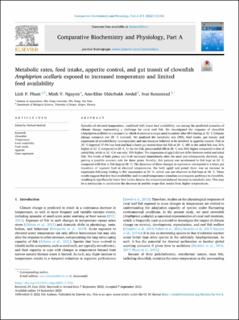Metabolic rates, feed intake, appetite control, and gut transit of clownfish Amphiprion ocellaris exposed to increased temperature and limited feed availability
Journal article, Peer reviewed
Published version

Åpne
Permanent lenke
https://hdl.handle.net/11250/3028222Utgivelsesdato
2022Metadata
Vis full innførselSamlinger
- Department of Biological Sciences [2290]
- Registrations from Cristin [10412]
Originalversjon
Comparative Biochemistry and Physiology A. 2022, 274, 111318. 10.1016/j.cbpa.2022.111318Sammendrag
Episodes of elevated temperature, combined with lower feed availability, are among the predicted scenarios of climate change representing a challenge for coral reef fish. We investigated the response of clownfish (Amphiprion ocellaris) to a scenario in which it received a single meal to satiety after 48 h fasting at 32 °C (climate change scenario) and 28 °C (control). We analysed the metabolic rate (MR), feed intake, gut transit, and expression of selected brain neuropeptides and one receptor believed to be involved in appetite control. Fish at 32 °C ingested 17.9% less feed and had a faster gut transit than did fish at 28 °C. MR in the unfed fish was 31% higher at 32 °C compared to 28 °C. In the fed fish, postprandial MR at 28 °C was 30% higher compared to that of unfed fish, while at 32 °C it was only 15% higher. The expression of agrp1 did not differ between unfed and refed fish. The levels of both pomca and mc4r increased immediately after the meal and subsequently declined, suggesting a possible anorexic role for these genes. Notably, this pattern was accelerated in fish kept at 32 °C compared with that in fish kept at 28 °C. The dynamics of these changes in expression correspond to a faster gut transition of ingested feed at elevated temperatures. For both agrp2 and pomcb there was an increase in expression following feeding in fish maintained at 32 °C, which was not observed in fish kept at 28 °C. These results suggest that low feed availability and elevated temperature stimulate anorexigenic pathways in clownfish, resulting in significantly lower feed intake despite the temperature-induced increase in metabolic rate. This may be a mechanism to ameliorate the decrease in aerobic scope that results from higher temperatures.
